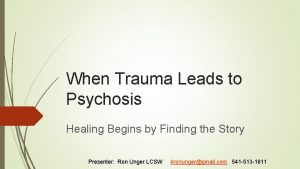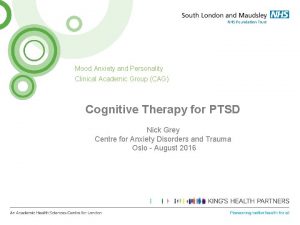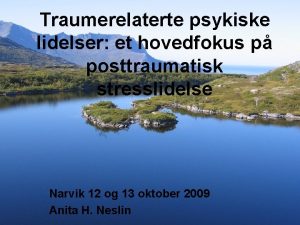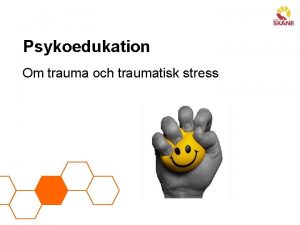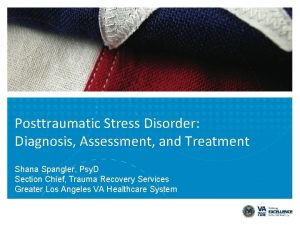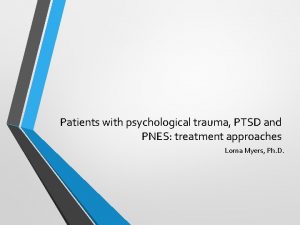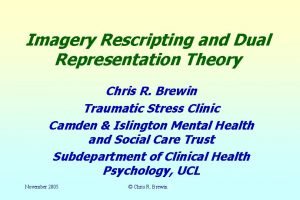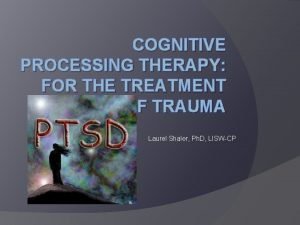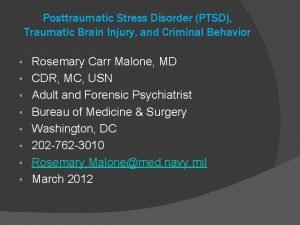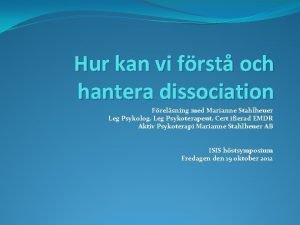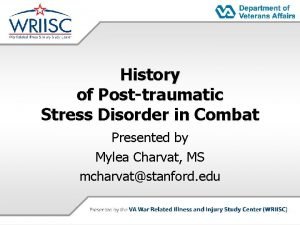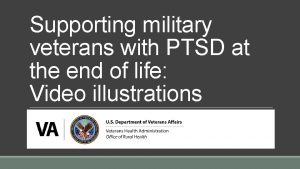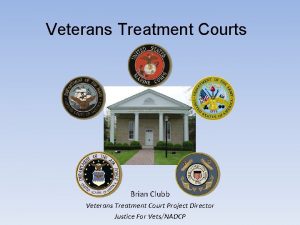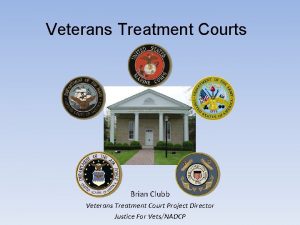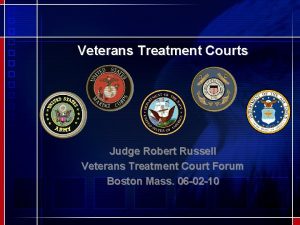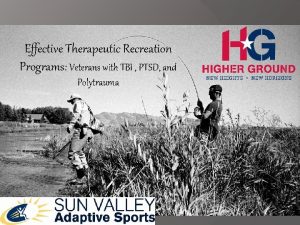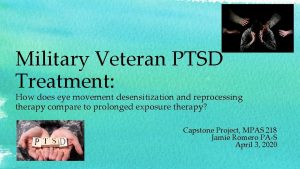Treatment Programs for Military Veterans with PTSD and















- Slides: 15

Treatment Programs for Military Veterans with PTSD and Comorbid Mental Health Diagnoses Savannah Pierce, Diamond Ray & Mackenzie Shornak Longwood University

#treatment. NOTjudgeme nt https: //youtu. be/C 0 ha 75 na 03 s

Post Traumatic Stress Disorder (PTSD) PTSD is the result of experiencing a traumatic event during the war, such as combat, or a non-war traumatic event, such as a terrorist attack, family violence, sexual assault, or serious injury ★ Individuals with PTSD continue to experience the psychological effects of trauma ○ ○ Re-experiencing symptoms Avoidance of similar stimuli Negative cognition and mood Increased physical arousal (Ghaffarzadegan, Ebrahimvandi, & Jalali, 2016)

Did you know…?

Did you know…?

Did you know…? ★ More than 2% of the US population (about 7. 7 million people) suffer from PTSD ○ 8 -9% of the US population report experiencing lifetime PTSD (Ghaffarzadegan, Ebrahimvandi, & Jalali, 2016) ★ Since 9/11, there has been an increase for both men and women military personnel to seek mental health services (Menefee et al. , 2016) ★ Practicing mindfulness, yoga and psychoeducation techniques can be helpful in reducing PTSD symptoms in veterans (Zalta et al. , 2018) ★ Service dogs have been studied as an additional treatment for military personnel and veterans with PTSD ○ Results showed decrease in signs of PTSD when having a service dog (O’Haire, & Rodriguez, 2018)

Comorbidity ★ Common trends show veterans with (PTSD) display comorbid symptoms: ○ Suicidal ideation ○ Depression ○ Substance abuse ★ There is a mental health concern with veterans and the relation of suicide and PTSD (Koven, 2017) ★ Surveys show military personnel on active duty display binge drinking behaviors (Allen, Crawford & Kudler, 2016)

Inpatient Treatment Program: Symptom Cluster ★ Individual and group therapy program ★ Intake assessments and 3 -9 month follow up ★ Authors used a “four-factor model” in the DSM-V to divide each symptom into four clusters ★ Concluded that all symptom clusters greatly decreased during the individual and group treatment programs. ★ Results were steady during the 9 -month follow (Phelps, Steele, Metcalf, Alkemade, and Elliot, 2018)

Inpatient Treatment Program: Trauma-Focused Treatment for Veterans ★ Authors suggested to treat PTSD and comorbid symptoms simultaneously ★ ROVER/WISER Program ○ ○ 4 -5 week intensive program Provides Evidence-based Therapy (EBT) for PTSD and integrates skill building for “affective regulation and interpersonal effectiveness” (Menefee, Leopoulos, Tran, Tang, Wanner, Wilde, and Day, 2016)

Outpatient Treatment Program: Cognitive Processing Therapy ★ Two-week treatment program ★ Evaluated effectiveness of cognitive processing therapy for veterans with PTSD ★ Results displayed reduced symptoms at the end of the trial and at a sixmonth follow up (Bryan, Leifker Rozek, Bryan, Reynolds, Oakey, & Roberge, 2018)

Outpatient Treatment Program: Anger Management ★ Anger levels affect ability to cope with PTSD symptoms ★ Veterans with and without PTSD symptoms in addition to comorbid diagnosis ★ Completed anger management program ★ Results: significant improvement in overall mood (Smith and Cruz, 2018)

Outpatient Treatment Program: Evidence-based Treatments ★ Evaluate change in symptoms with PTSD and depression ★ Three-week intensive program ★ Observed 191 veterans before and after therapeutic sessions ○ ○ ○ Mindfulness Yoga Psychoeducation ★ Results: significant decrease in PTSD and depression symptoms (Zalta et al. , 2018)

Research Question ★ What is the most effective way to treat veterans with PTSD and other comorbid disorders? ○ Will the effects of the treatment last? How long? ○ Is there a specific order to treating PTSD and the comorbid symptoms? ○ Will they continue to receive outpatient assistance?

Methods of Proposed Research ★ Participants: Military Veterans ○ ○ In any branch of the military Honorably discharged veteran Male or female Age: 18+ ★ Purposive + Snowball sampling ★ Methods of Research: Phenomenological Qualitative approach ○ ○ ○ Semi-structured interview Survey created by the Anxiety and Depression Associated of America (ADAA) Screening for Posttraumatic Stress Disorder (PTSD). Anxiety and Depression Association of America, ADAA

QUESTIONS
 Osu military and veterans services
Osu military and veterans services Disadvantages of waterfall model in software engineering
Disadvantages of waterfall model in software engineering Psychosis and ptsd
Psychosis and ptsd Ptsd model ehlers and clark
Ptsd model ehlers and clark Ptsd norsk
Ptsd norsk Macbeth hamartia quotes
Macbeth hamartia quotes Psykoedukation ptsd
Psykoedukation ptsd Va ptsd rating scale pdf
Va ptsd rating scale pdf Ptsd seizures
Ptsd seizures Dual representation theory ptsd
Dual representation theory ptsd Ptsd spiritual warfare
Ptsd spiritual warfare Cpt stuck points examples
Cpt stuck points examples Remains poem simon armitage
Remains poem simon armitage Ptsd violent behavior
Ptsd violent behavior Toleransfönster
Toleransfönster Evolution of ptsd
Evolution of ptsd


